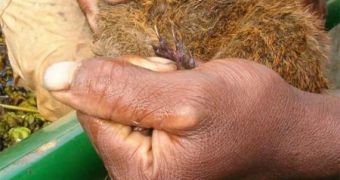The newest carnivore, known as Durrell's vontsira, or Salanoia durrelli, is a cat-sized mammal that has been identified very fast as being a new species, and its discoverers say that it is also one of the most threatened animals in the world.
The little beast was found hiding in the Lac Alaotra wetlands in central eastern Madagascar, after being spotted swimming in a lake, by a team of researchers, part of the Durrell Wildlife Conservation Trust, who were on a field trip surveying bamboo lemurs (Hapalemur griseus alaotrensis), back in 2004.
After the Durrell's vontsira was captured, it turned out it weighs only little over a pound ( just over 0.5kg) and it belongs to a family of carnivores, that was only known to come from Madagascar.
Thinking they have found a new species, the team members took pictures of it, and later compared them to specimens of the Durrell's vontsira, which are available in the collections of the Natural History Museum.
The comparison confirmed that it was actually a new species, and also the closest relative of the brown-tailed vontsira.
Fidimalala Bruno Ralainasolo, a conservation biologist working for Durrell Wildlife Conservation Trust who originally captured the creature, says that people new for some time that in the Lac Alaotra marshes lived a carnivore, but they simply assumed it was a brown-tailed vontsira, like the one living in the eastern rainforests.
“However, differences in its skull, teeth, and paws have shown that this animal is clearly a different species with adaptations to life in an aquatic environment,” he adds.
Discovering a new species is always good news, but the Durrell's vontsira's habitat is actually threatened by agriculture, by burning and by invasive plants, said the researchers.
And as there is nothing official about the conservation status of this new species, its small population size also becomes a threat, along with its limited distribution – it can only be found in Madagascar.
Study researcher Frank Hawkins of Conservation International, said that there are chances that this carnivore could be “of the smallest ranges in the world, and likely to be one of the most threatened.”
The latest issue of the taxonomic journal Systematics and Biodiversity presents the findings in detail, LiveScience reports.

 14 DAY TRIAL //
14 DAY TRIAL //